Insightful Seminar on “FPGA Accelerators in the Cloud” by Prof. Viktor Prasanna of University of Southern California(USC).
On 30th July 2025, the department had the opportunity to host Professor Viktor Prasanna from the University of Southern California (USC) for a seminar on FPGA Accelerators in the Cloud at ENTC1. His talk explored one of the most dynamic areas in high-performance computing, offering valuable insights into this fast-growing field.
Professor Prasanna explained the complex yet crucial role of Field-Programmable Gate Arrays (FPGAs) in revolutionizing cloud-based applications. He highlighted current industry trends and cutting-edge research, explaining how FPGAs are being deployed to accelerate demanding workloads such as machine learning, real time data analysis, and complex scientific simulations. The session provided a clear vision of the future, where reconfigurable hardware is becoming essential for achieving next-level performance and efficiency in the cloud.
The talk was far more than a one way lecture; it evolved into a dynamic and interactive session. The presentation sparked a stimulating discussion, with both students and staff members posing intriguing questions. Professor Prasanna concluded the discussion by encouraging all students interested in the field to apply for graduate studies and internships at his lab at USC.
We extend our heartfelt gratitude to Professor Prasanna for sharing his profound expertise and for engaging so generously with our community. The insights shared will undoubtedly inspire further research and academic pursuits among our attendees. A special thank you to everyone who participated and contributed to the vibrant discussion.
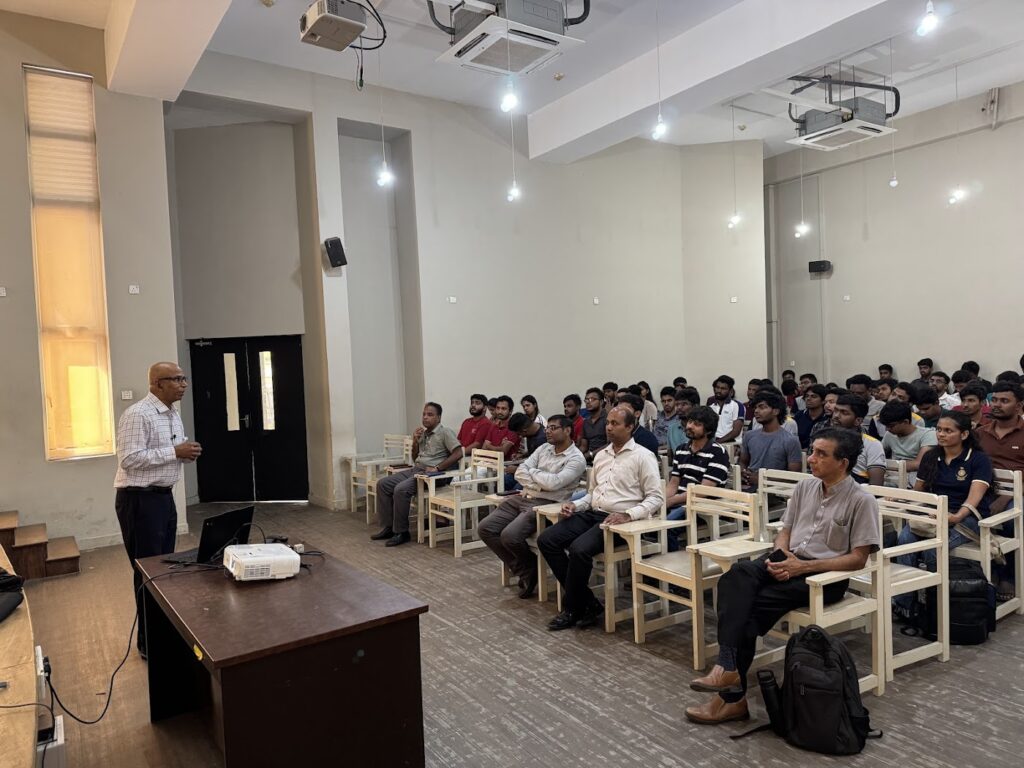
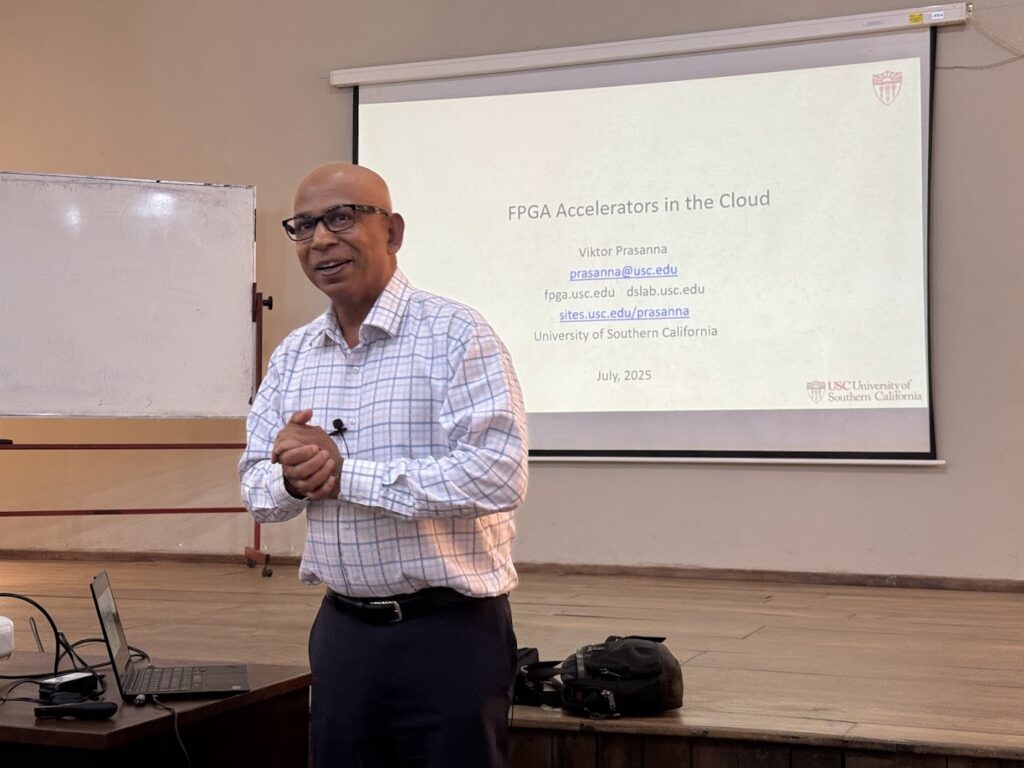
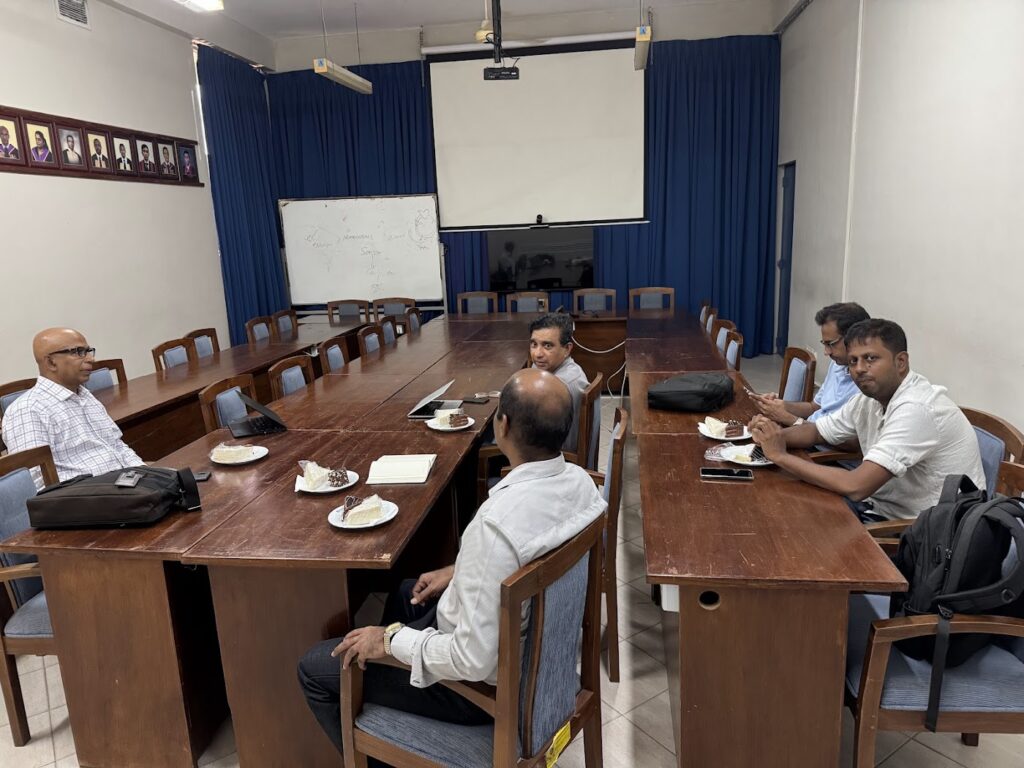
𝗖𝗲𝗹𝗲𝗯𝗿𝗮𝘁𝗶𝗻𝗴 𝗜𝗻𝗻𝗼𝘃𝗮𝘁𝗶𝗼𝗻 𝗮𝘁 𝗦𝗣𝗔𝗥𝗞 𝟮𝟬𝟮𝟱
On Saturday, August 2nd, we witnessed an incredible showcase of student ingenuity at the SPARK Challenge, held in Colombo.
This event brought together some of the brightest young innovators tackling real-world challenges through sustainable and scalable engineering solutions. We are proud to announce this year’s winners:
Champions – Team Zypher
Project: BSFix – A Revolutionary Black Soldier Fly (BSF) Farming Unit
Led by Demitha Manawadu, Team Zypher introduced a compact, odor-controlled, and scalable BSF system to convert organic waste into animal feed and compost. Their solution combats methane emissions, supports SDG 13 (Climate Action), and promotes circular economy practices.
1st Runners-Up – Team Dyson Sphere
Project: SEIAN – Smart Energy Integration and Automation Network
Led by Rusula Oshadha Pathirana, this team designed an intelligent, fault-tolerant inverter system that maintains grid stability during outages and supports the growth of decentralized renewable energy systems.
2nd Runners-Up – Team Rysera
Project: URO MONITOR – Smart Urine Output Monitoring System
Led by Sahan Cooray, Team Rysera developed an IoT-enabled medical device to automate urine output tracking in ICUs and dengue wards—boosting accuracy, reducing nurse workload, and improving patient care in Sri Lanka’s hospitals.
Congratulations to all the winning teams for your innovation, teamwork, and commitment to engineering solutions that matter. The SPARK Challenge continues to be a launchpad for real impact!

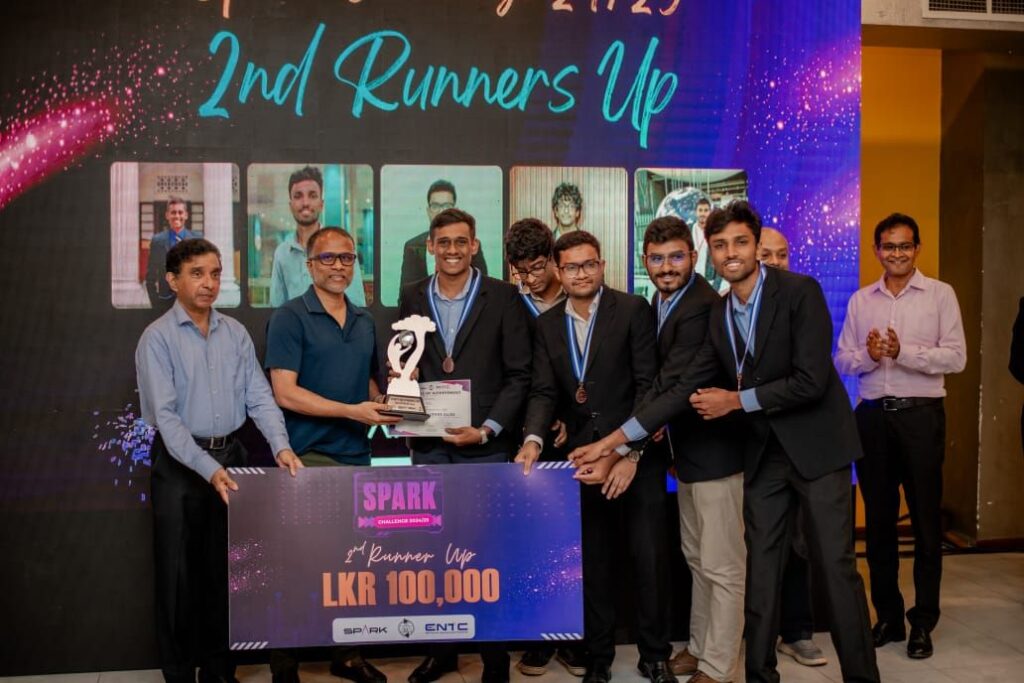
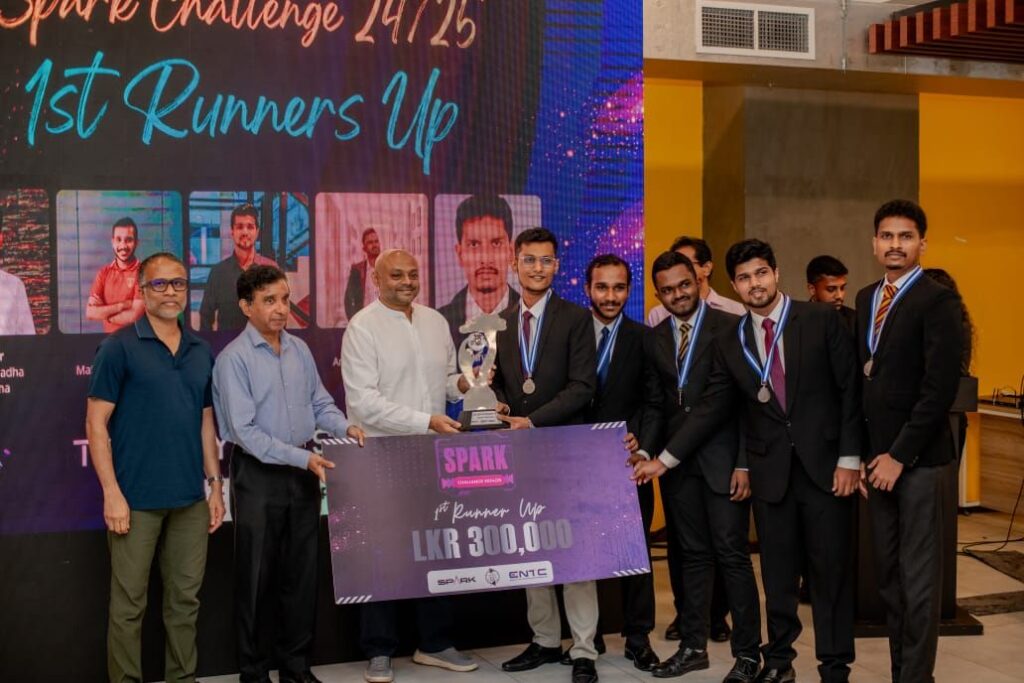
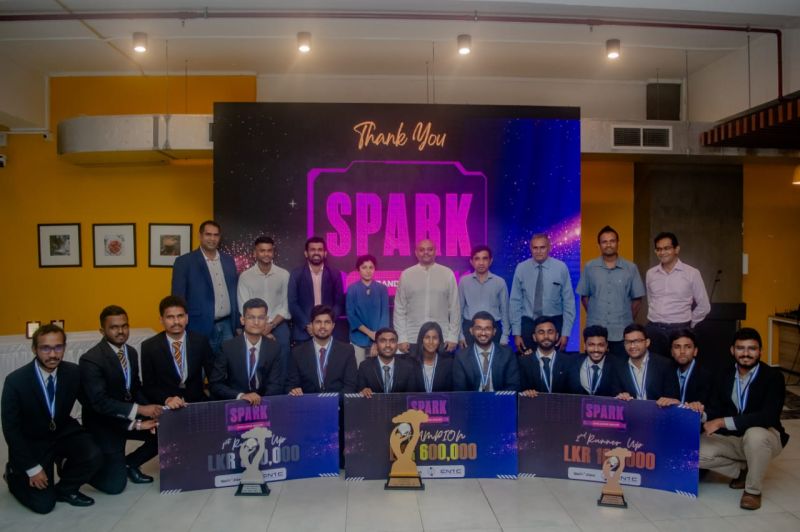
University of Moratuwa Enhances Innovation with Raspberry Pi 4 Model B Gifting
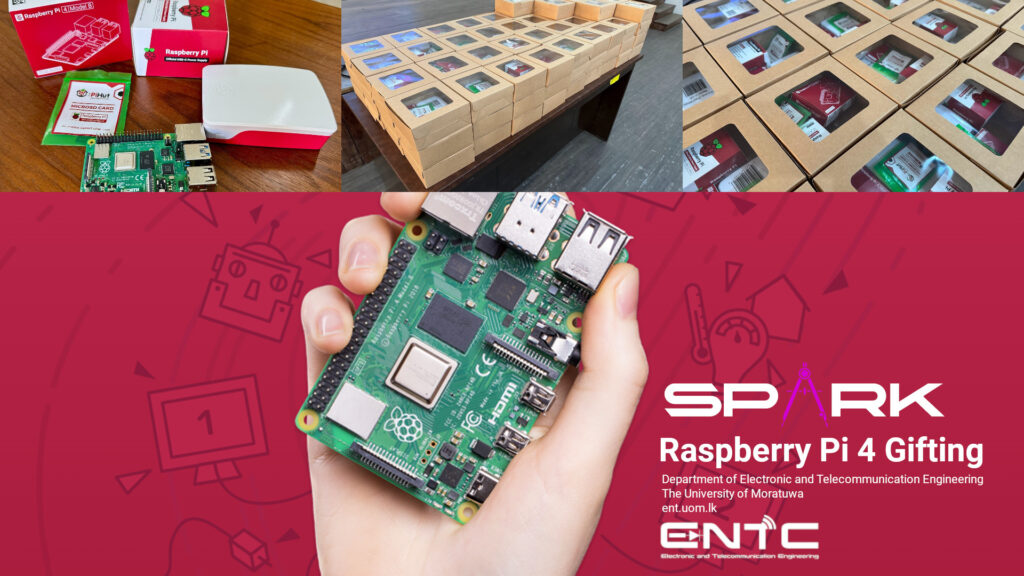
Moratuwa, Sri Lanka – March 14, 2024 – In a significant step towards fostering technological innovation and hands-on learning, the Department of Electronic and Telecommunication Engineering at the University of Moratuwa has gifted Raspberry Pi 4 Model B kits to all 115 students of the 2021 intake. This initiative is a part of the SPARK program, which aims to encourage students to engage in innovative projects and challenges.
The Raspberry Pi 4 Model B, renowned for its robust capabilities, offers students a versatile platform for a wide range of projects. Equipped with a quad-core Cortex-A72 (ARM v8) 64-bit SoC, LPDDR4-3200 SDRAM, and dual-display support at resolutions up to 4K via a pair of micro-HDMI ports, the Raspberry Pi 4 is a powerful tool for developing complex computing solutions. Its gigabit Ethernet and USB 3.0 connectivity also make it suitable for high-speed data transfer and network projects.
The head of the department, highlighted the significance of this initiative, stating, “The Raspberry Pi 4 Model B kits provide our students with the essential tools to explore, innovate, and create. These devices will not only assist them in their coursework but also inspire them to participate in the SPARK Challenge and other innovative activities.”
Innovative Projects and Real-World Applications
The Raspberry Pi has already been instrumental in several notable student projects at the university. One such project, sponsored by Dialog Axiata PLC, is the Virtual Cycling Project. Utilizing a VR headset, this project enables users to experience virtual cycling through Sri Lanka’s breathtaking mountainous routes. The Raspberry Pi served as the primary controller, showcasing its potential in virtual reality applications.
Another impressive project involved digital IC replication, where the Raspberry Pi generated patterns to train a neural network module, demonstrating its capability in advanced digital signal processing and machine learning applications.
There have been numerous such project using Pis.
The SPARK Challenge: Driving Innovation
The SPARK Challenge is a yearlong endeavor designed to encourage students to develop unique and novel products that address the adverse effects of climate change. The challenge emphasizes the creation of sustainable solutions and aims to foster the growth of new commerce and industry in Sri Lanka. Teams of five students will present their solutions to external specialists in a format reminiscent of “Shark Tank” or “Dragons’ Den.”
To support the students, the SPARK program and the department provide comprehensive training and resources, including:
– Modern Design Workshops: Eight facilitated workshops that help teams formulate and deliver strong, innovative solutions.
– Briefing Sessions on UN Sustainable Development Goals (UN-SDGs): Guidance on developing sustainable products and services.
– Agile Methodology Training: Enabling rapid iteration of software and hardware solutions.
Dr. Ajith Pasqual expressed his optimism about the program, stating, “The SPARK Challenge is a platform for our students to not only demonstrate their technical skills but also to create impactful solutions that can drive sustainable development in Sri Lanka. We are excited to see the innovative ideas that will emerge from this initiative.” Nisitha Silva, Vice President of the Electronic Club that runs the SPARK program too spoke.
Fostering Future Innovators
By providing the Raspberry Pi 4 Model B kits, the University of Moratuwa is investing in the future of its students, equipping them with the tools needed to excel in the rapidly evolving tech landscape. This initiative aligns with the university’s commitment to fostering innovation, creativity, and practical problem-solving skills among its students.
The SPARK program and the gifting of Raspberry Pi kits symbolize a forward-thinking approach to education, where students are encouraged to push the boundaries of what is possible and contribute to the technological and industrial growth of Sri Lanka.
For more information on the SPARK program and the innovative projects at the University of Moratuwa, please visit [University of Moratuwa – Department of Electronic and Telecommunication Engineering.
Read MoreRenowned Expert Prof. Anna Förster Enlightens University of Moratuwa on Sustainable Communication Networks
Prof. Anna Förster, a distinguished researcher from COMNETS, University of Bremen, Germany, graced the halls of the University of Moratuwa on Wednesday, February 7th, 2024, captivating attendees with her insights into Sustainable Communication Networks and postgraduate study prospects in Germany.

Addressing an audience in the Electronic and Telecommunications department, Dr. Förster delved into her pioneering research, which focuses on self-organizing and autonomous sensor networks, opportunistic networks, and underground sensor networks. Utilizing a blend of artificial intelligence techniques such as machine learning and swarm intelligence, she sheds light on various aspects of wireless communication protocols and applications.
One of the highlights of Dr. Förster’s research is its practical applications, aimed at contributing to the global achievement of Sustainable Development Goals. These applications span decision agriculture, environmental monitoring, safety monitoring, health applications, and more. Additionally, her work emphasizes the usability of Internet of Things (IoT) applications to maximize their impact and utility.
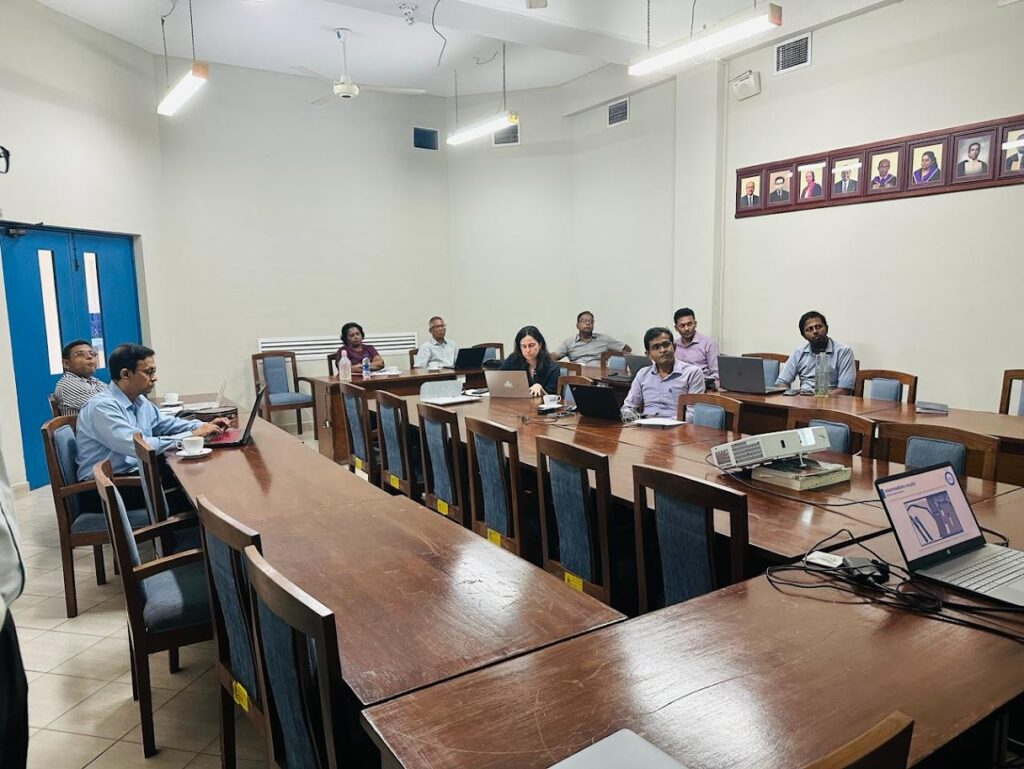

During her visit to the University of Moratuwa, Dr. Förster engaged in multifaceted activities, including providing feedback on final-year project mid-evaluations and delivering illuminating talks on her research on sustainability and IoT. Furthermore, she shared invaluable insights into studying in German universities, offering aspiring scholars a glimpse into the educational opportunities available in her home country.
Read MoreSpark Challenge Crowns Champions After Electrifying Grand Finale!
The Department of Electronic and Telecommunication Engineering at the University of Moratuwa buzzed excitedly on June 7th, 2023, as the Spark Challenge 2022/23 held its much-anticipated pitching Session. Teams brimming with innovative ideas battled it out, leaving the judges with a tough decision.
Five teams were chosen to advance to the Grand Finale following the session, marking the culmination of nearly a year of brainstorming and development. At the finale, which was held on the 11th of June 2023 at the Civil Auditorium, the top five competitors presented their final pitches. After an exciting final round, the winners were invited onto the stage. Team Spectro, who proposed a solution to the energy crisis where biological processes of green algae could be used to produce hydrogen power, emerged as the second runner-up of the challenge. Then the first runner-up award went to the team Techstatic, who implemented a product which had the capability of warning the farmers about the fertilizing requirements after analyzing the soil condition. Then, finally, the winner was the Team Pathfinders, who came up with a solution for picking up the right balance of chemical composition for different crops.

A true engineer must engage in professional-level projects that address real problems the world faces. The SPARK challenge will reward individuals and groups that create unique, innovative, socially, and environmentally responsible solutions to bring about significant positive transformative impact on society, industry and the wider environment. We had many students getting engaged with electronic-telecom projects over a period of one year under this challenge.
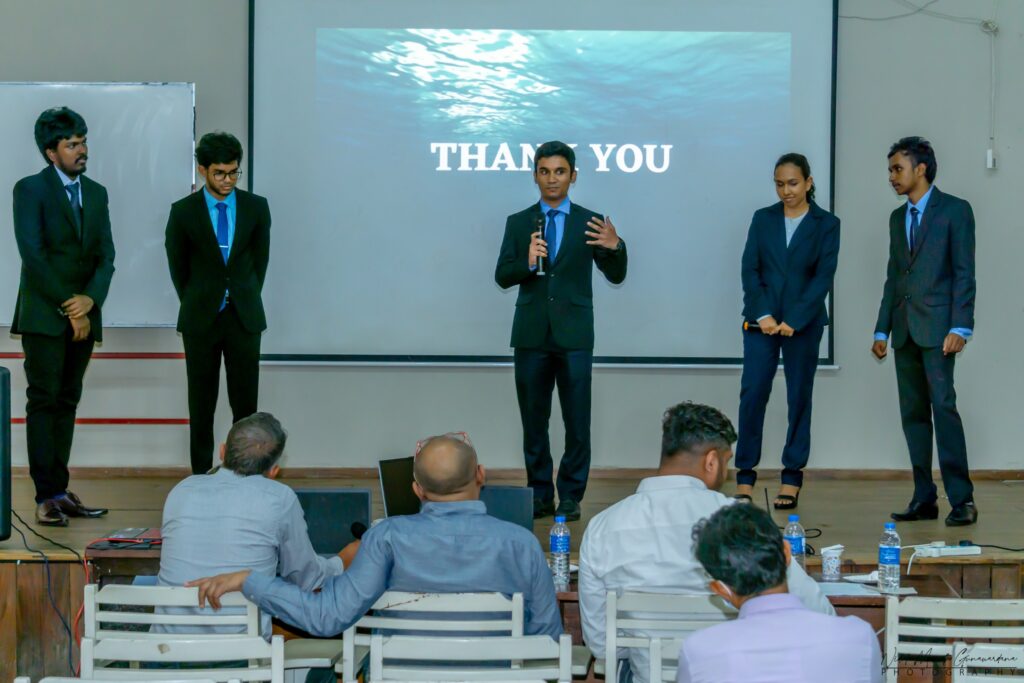
Congratulations to all the participants who poured their hearts into the competition! The Spark Challenge continues to be a breeding ground for Sri Lanka’s brightest minds, fostering solutions for a sustainable future. SPARK challenge will continue with another episode in 2024.
Read MoreWorkshop on Quantum Computing
The Electronic and Telecommunication Engineering Department of the University of Moratuwa, in collaboration with the UBC Quantum Club, IEEE Sri Lanka Section, and Skill Surf, organized a one-day workshop on “Introduction to Quantum Computing” on January 21, 2023. The workshop aimed to introduce participants to the basics of quantum computing, its applications, and its future potential. The workshop featured key resource personnel who are experts in the field of quantum computing. Dr. Harini Hapuarachchi from RMIT University, Australia, Mr. Kithmin Wickremasinghe from the University of British Colombia, Canada, Mr. Ravi Tharaka from Monash University, Australia, and Theshani Nuradha from Cornell University, USA, were the keynote speakers for the workshop.
The one-day workshop attracted a significant number of participants, including students, academics, and industry professionals. The workshop offered a comprehensive introduction to the basics of quantum computing, including quantum mechanics, qubits, quantum gates, quantum circuits, and quantum algorithms. Participants also had the opportunity to learn about quantum computing applications in various fields, including cryptography, machine learning, and optimization. The workshop included interactive sessions, demonstrations, and hands-on exercises to provide a practical understanding of the concepts covered in the lectures. The resource personnel also provided valuable insights into the future of quantum computing and the opportunities it presents.
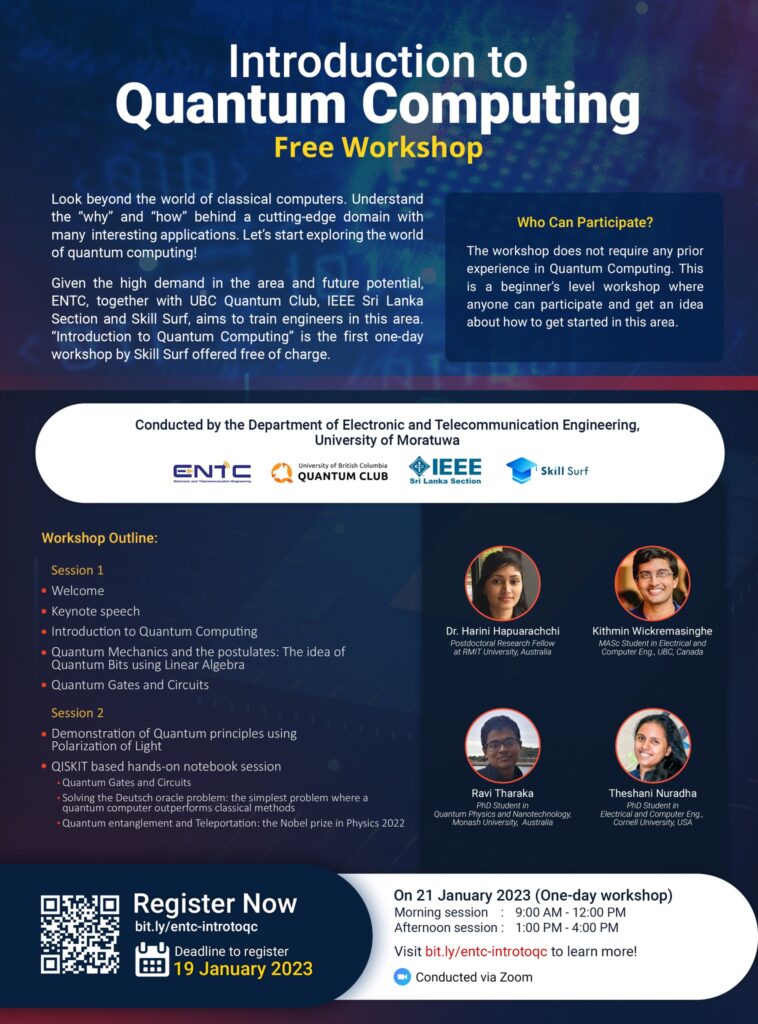
The workshop was a great success, with participants expressing their satisfaction with the content and delivery of the program. The participants also had the opportunity to network and exchange ideas with the experts in the field. The organizers of the workshop thanked the resource personnel, participants, and sponsors for making the event a success. They also encouraged participants to continue to explore the world of quantum computing and stay updated with the latest developments in the field.
Overall, the “Introduction to Quantum Computing” workshop was a great initiative by the Electronic and Telecommunication Engineering Department of the University of Moratuwa, together with its partners. The department has a thrust area in quantum computing. The workshop was an excellent opportunity for participants to expand their knowledge and skills in quantum computing and explore the exciting potential of this emerging field.
Read MoreSPARK Pitching Sessions
SPARK project aims to drive projects that solve crucial problems that mankind faces such as climate change, food scarcity, and inequality in education though the application of engineering principles. All these are important aspects of the 17 Sustainable Development Goals (https://sdgs.un.org/goals). Approximately 35 student teams worked on developing solutions to problems that address one or more such goals. Ten groups were able to propose fully-developed ideas and make prototypes. This was possible after a long-term training provided by SAPRK with the involvement of foreign trainers.
As the culmination of this year-long process, the ten groups pitched their projects to an eminent panel of judges comprising Mr. Heminda Jayaweera, Mr. Fayaz Hudah, Mr. Chalinda Abeykon and Mr. Josh Robsen. This pitching session took place on July 24, 2022 at the Department of Electronic and Telecommunication Engineering in a vibrant setting with many students and staff members watching and deliberating about the possible impact of the projects.
Read MoreMulti-Label Reduced-Lead EEG Classification Using CNNs
Nima Wickramasinghe from the Department of Electronic and Telecommunication Engineering (ENTC), together with his mentor Mohamed Athif from the Department of Biomedical Engineering, Boston University (previously an undergraduate at ENTC) have written a research paper, titled “Multi-label Classification of Reduced-lead ECGs using an Interpretable Deep Convolutional Neural Network” which has been accepted to be published in the journal Physiological Measurement as a special issue paper.
In their work, they propose a novel method to identify the presence of 26 cardiac abnormalities in an ECG recording with reduced leads. Even though most of the previous work relies on 12-lead ECGs, classification using reduced leads remained unexplored. In their research, they trained a deep convolutional neural network to classify the ECG recordings and showed that the reduced-lead model performs comparably to the 12-lead model. In addition to accurately classifying the cardiac abnormalities, they have used SHAP (shapley additive explanations: a game-theoretic approach used to explain the output of any machine learning model) to interpret the deep learning model. The authors identified that the model learns almost the same diagnostic criteria used by cardiologists to classify cardiac abnormalities. By analyzing the model through SHAP, they were able to detect why the model underperforms in some of the classes, which was mainly due to the lack of discriminating features in reduced leads, labeling inconsistencies in the dataset, and low number of samples.
Physiological Measurement is a journal that covers the quantitative measurement and visualization of physiological structure and function in clinical research and practice, with an emphasis on the development of new methods of measurement and their validation. The Sustainable Education Foundation facilitated the collaboration between the 2 authors.
DOI Link to the paper: https://doi.org/10.1088/1361-6579/ac73d5
Read MoreMr. Pasan Dissanayake and Dr. Prathapasinghe Dharmawansa of ENTC have Published Two Research Papers in the Prestigious Journal IEEE Transactions on Information Theory
Two research papers written by Mr. Pasan Dissanayake and Dr. Prathapasinghe Dharmawansa of ENTC have been published in the prestigious journal IEEE Transactions on Information Theory. IEEE Transactions on Information Theory is the world’s No. 1 journal in the areas of Information and Communication theory research. This truly exceptional achievement will make the research history of ENTC. This extraordinary academic achievement will be a guiding spirit for the current and future researchers in the entire university system of Sri Lanka. Moreover, it will help place ENTC among the top researchers in information and communication theory in the world. The details of the two papers are as follows.
1. Distribution of the Scaled Condition Number of Single-spiked Complex Wishart Matrices
This paper statistically characterizes the scaled condition number (SCN) of single-spiked complex Wishart matrices by deriving its density function. The statistical characteristics of the SCN and its variants have been instrumental in understanding many physical phenomena across a heterogeneous field of sciences. While numerical analysts and statistical physicists are interested in the behavior of the SCN for white Wishart matrices, the case corresponding to correlated Wishart matrices are of paramount importance in wireless communications and statistics. In particular, the SCN has been used as a performance metric in certain wireless signal processing applications involving multiple-input multiple-output (MIMO) systems, in which the antenna correlation gives rise to the correlated Wishart matrix. Recently, the SCN has been proposed as one of the test statistics for blind spectrum sensing in cognitive radio (CR) systems. The key concept behind CR is to opportunistically utilize the underutilized spectrum in view of improving the spectral efficiency of modern wireless networks. Against this backdrop, this paper leverages powerful random matrix theoretic techniques and the novel density of the SCN to statistically characterize the receiver operating characteristics (i.e., ROC) of the aforementioned detector. Since the modern wireless architectures facilitate the use of large antenna/sensor arrays with comparable observational sample acquisition, the analysis has been extended to the asymptotic regime in which the number of antennas of the detector and the samples diverge at the same rate so that their ratio remains constant. It turns out that, in this asymptotic regime, the statistical power of the SCN based detector can be approximated by the most celebrated Tracy-Widom distribution corresponding to the complex matrices. Moreover, numerical results have revealed that those asymptotic results compare favourably with their not so large dimensional counterparts.
2. The Eigenvectors of Single-spiked Complex Wishart Matrices: Finite and Asymptotic Analyses
This paper investigates the finite dimensional distributions of the eigenvectors corresponding to the extreme eigenvalues (i.e., the minimum and the maximum) of single-spiked complex Wishart matrices. These spikes arise in various practical settings in different scientific disciplines. For instance, they correspond to the first few dominant factors in factor models arising in financial economics, the number of clusters in gene expression data, and the number of signals in detection and estimation theory. In particular, the focus is on the distributions of the squared modulus of the eigen-projectors (i.e., projection of the spiked-vector onto the leading and least eigenvectors) of single-spiked Wishart matrices. This metric is commonly used to infer information about the latent spiked-vector using the eigenvectors of the sample covariance matrix. A concrete example in this respect is the principal component analysis (PCA) in which the eigenvectors of the unknown population covariance matrix is approximated by the eigenvectors of the sample covariance matrix. This metric has further been used in the covariance estimation based on the optimal shrinkage of the eigenvalues of the sample covariance matrix in the high dimensional setting when the unobserved population covariance matrix assumes the spiked structure. This paper leverages the powerful contour integral representation of unitary integrals and orthogonal polynomial techniques to derive closed-form expressions for the densities of the above metrics. A somewhat surprising stochastic convergence result pertaining to the above metrics has also been established. Finally, the same analytical framework has been extended to derive the corresponding destines for real and singular Wishart scenarios; however, with closed-form solutions limited to a few special configurations only.


